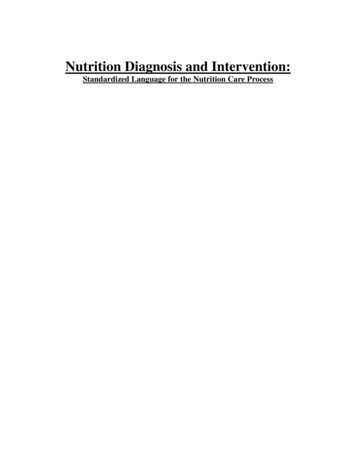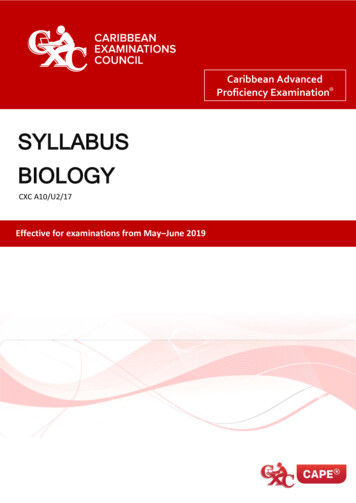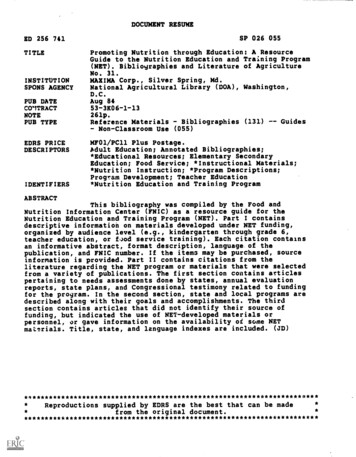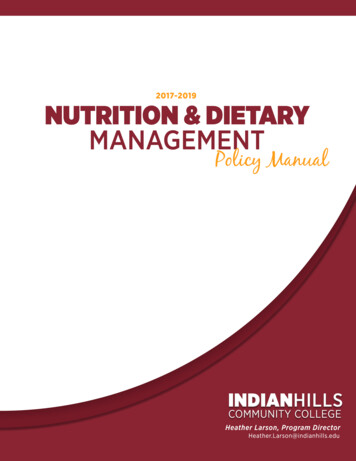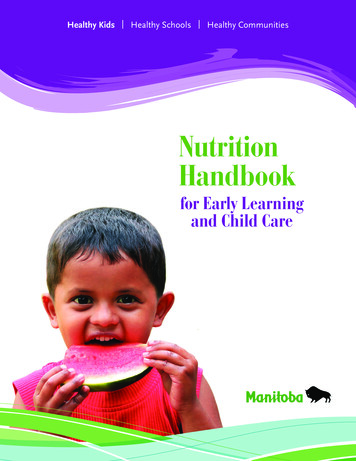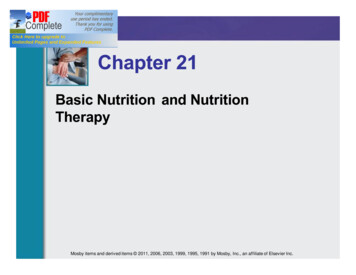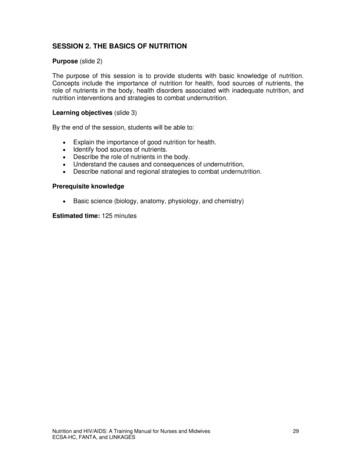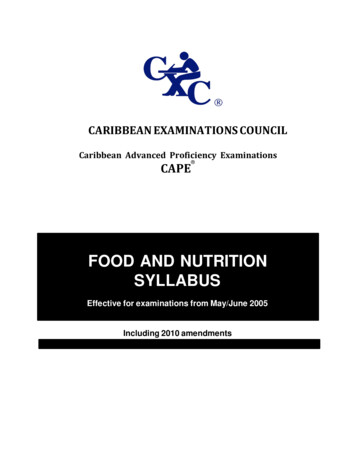
Transcription
CARIBBEAN EXAMINATIONS COUNCILCaribbean Advanced Proficiency ExaminationsCAPE FOOD AND NUTRITIONSYLLABUSEffective for examinations from May/June 2005Including 2010 amendmentsCXC A26/U2/04
Published by the Caribbean Examinations CouncilAll rights reserved. No part of this publication may be reproduced, stored in a retrieval system, ortransmitted in any form, or by any means electronic, photocopying, recording or otherwise without priorpermission of the author or publisher.Correspondence related to the syllabus should be addressed to:The Pro-RegistrarCaribbean Examinations CouncilCaenwood Centre37 Arnold Road, Kingston 5, Jamaica, W.I.Telephone: (876) 630-5200Facsimile Number: (876) 967-4972E-mail address: cxcwzo@cxc.orgWebsite: www.cxc.orgCopyright 2004 by Caribbean Examinations CouncilThe Garrison, St Michael BB14038, BarbadosCXC A26/U2/04
ContentsRATIONALE . 1AIMS . 2SKILLS AND ABILITIES TO BE ASSESSED . 2 - 3PRE-REQUISITES OF THE SYLLABUS . 4STRUCTURE OF THE SYLLABUS . 4UNIT 1: FOOD, NUTRITION AND HEALTHMODULE 1: PRINCIPLES OF NUTRITION AND HEALTH . 5 - 9MODULE 2: FOOD SELECTION AND MEAL PLANNING . 10 - 14MODULE 3: FOOD PREPARATION AND SERVICE: PRINCIPLES ANDMETHODS. 15 - 19UNIT 2: FOOD TECHNOLOGYMODULE 1: CARIBBEAN FOODWAYS AND FOOD SYSTEMS . 20 - 24MODULE 2: FOOD SCIENCE AND TECHNOLOGY . 25 - 28MODULE 3: FOOD PREPARATION AND SERVICE: LARGE QUANTITYAND COMMERCIAL . 29 - 34OUTLINE OF ASSESSMENT . 35 - 41REGULATIONS FOR PRIVATE CANDIDATES. 42REGULATIONS FOR RE-SIT CANDIDATES. 42ASSESSMENT GRID . 42MINIMUM EQUIPMENT LIST. 43 - 44GLOSSARY . 45 – 48CXC A26/U2/04
CXC A26/U2/04
TIntroductionThe Caribbean Advanced Proficiency Examination (CAPE) is designed to provide certification ofthe academic, vocational and technical achievement of students in the Caribbean who, havingcompleted a minimum of five years of secondary education, wish to further their studies. Theexaminations address the skills and knowledge acquired by students under a flexible and articulatedsystem where subjects are organised in 1-Unit or 2-Unit courses with each Unit containing threeModules. Subjects examined under CAPE may be studied concurrently or singly.The Caribbean Examinations Council offers three types of certification. The first is the award of a certificateshowing each CAPE Unit completed. The second is the CAPE diploma, awarded to candidates who havesatisfactorily completed at least six Units, including Caribbean Studies. The third is the CAPE AssociateDegree, awarded for the satisfactory completion of a prescribed cluster of seven CAPE Units includingCaribbean Studies and Communication Studies. For the CAPE diploma and the CAPE Associate Degree,candidates must complete the cluster of required Units within a maximum period of five years.Recognized educational institutions presenting candidates for CAPE Associate Degree in one of the ninecategories must, on registering these candidates at the start of the qualifying year, have them confirm in therequired form, the Associate Degree they wish to be awarded. Candidates will not be awarded any possiblealternatives for which they did not apply.CXC A26/U2/04
TFood and Nutrition Syllabus RATIONALEIn the light of increasing nutrition-related illnesses in the world, it is necessary to find new ways to empowerindividuals and communities to exercise control over their health. Proper nutrition practices hold the key tothe prevention and treatment of the chronic degenerative diseases that affect families globally.It is now well established that the achievement and maintenance of optimal physical and mental health, andthe prevention of disease, are integral to the economic and social development of the people of the CaribbeanRegion. The integration of preventive and therapeutic nutrition into contemporary health care and foodproduction and service is pivotal to this process.Food and Nutrition involves the study of food and its relation to health. The primary focus of the subject isthe raising of standards in food science, food preparation and service.This syllabus in Food and Nutrition is designed to prepare students for employment in the rapidly growinghospitality service industry. The syllabus also seeks to change attitudes and to improve the health status ofboth the individual and the community. In addition, the syllabus seeks to provide additional opportunity foraccess to, and advanced standing in existing tertiary level education programmes. Students will be exposed tothe main aspects of food science, including safety practices, standards, purchasing, planning, preparing, storingand serving.The syllabus also contributes to the development of selected attributes from the CARICOM Ideal Person document as articulatedby the CARICOM Heads of Government. This person is one who demonstrates emotional security with a high level of selfconfidence and self-esteem, is aware of the importance of living in harmony with the environment and nurtures its development inthe economic and entrepreneurial spheres in all other areas of life (CARICOM Education Strategy, 2000).This holistic development of students aligns with selected competencies advocated in the UNESCO Pillars of learning. These arelearning to be, learning to do, and learning to transform one’s self and society.Students who complete this programme in Food and Nutrition will be beneficiaries of knowledge and skillsthat would help them to secure good health and well-being for themselves and their families. Suchknowledge and skills, once acquired, would allow graduates to enter the world of work and be better preparedto pursue a wide range of contemporary careers related to diet, fitness and well-being.CXC A26/U2/041
AIMSThe syllabus aims to:1.promote an understanding of the cultural, environmental, socio-economic and other factors thatinfluence Food and Nutrition practices in the Caribbean;2.develop Food and Nutrition related skills and attitudes which will enhance the quality of life ofpeoples in the Caribbean;3.enable the making of informed choices regarding food consumption and physical activity patternsthat contribute to optimal health, and prevention of disease;4.prepare students to take advantage of various career opportunities in the field of Food andNutrition. SKILLS AND ABILITIES TO BE ASSESSEDThe skills students are expected to develop on completion of this syllabus, have been grouped under threeheadings:(i)(ii)(iii)Knowledge and Comprehension;Use of Knowledge;Practical and Experimental Skills.Knowledge and Comprehension (KC)KnowledgeThe ability to identify, remember, and grasp the meaning of basicfacts, concepts and principles.ComprehensionThe ability to:select appropriate ideas, match, compare and cite examplesof facts, concepts and principles in familiar situations;explain familiar phenomena in terms of theories, laws andprinciples.Use of Knowledge (UK)ApplicationCXC A26/U2/04The ability to:use facts, concepts, principles and procedures in unfamiliarsituations;transform data accurately and appropriately;use common characteristics as a basis for classification;use formulae accurately for computations.2
Analysis and InterpretationThe ability to:identify and recognise the component parts of a whole andinterpret the relationships between those parts;identify causal factors and show how they interact with eachother;infer, predict and draw conclusions;make necessary and accurate calculations and recognise thelimitations and assumptions of data.SynthesisThe ability to:combine component parts to form a new meaningful whole;make predictions and solve problems.EvaluationThe ability to make reasoned judgements and recommendationsbased on the value of ideas and information and their implications.Practical and Experimental Skills (PXS)Observation/Recording/ReportingThe ability to:recognise, identify and interpret signs and symptoms ofnutrition related conditions;present a written report, drawing or other graphicalrepresentation, which is clear, concise, accurate and relevantto an investigation, including the use of scientific andquantitative treatment if applicable;make written presentations;record and report unexpected results;record accurately microscopic and field observations;provide a bibliography in an appropriate format toaccompany written reports.Manipulation/MeasurementThe ability to:handle tools and equipment with care;assemble and use simple apparatusinstruments;handle foods with care.Planning/DesigningCXC A26/U2/04andmeasuringThe ability to:recognise the problem and formulate valid hypotheses;choose appropriate experimental research methods andsampling techniques;choose appropriate practical equipment and instruments fordata collection;plan and execute procedures in a logical sequence within thetime allotted;modify experimental methods after initial or unexpectedoutcomes.3
PRE-REQUISITES OF THE SYLLABUSAny person with a good grasp of the Caribbean Secondary Education Certificate (CSEC) Food and Nutrition, orChemistry, or Biology, or Integrated Science syllabuses or the equivalent, should be able to pursue the course ofstudy defined by this syllabus. However, successful participation in the course of study will also depend onpossession of good verbal and written communication skills. STRUCTURE OF THE SYLLABUSThe syllabus is divided into two Units. Each Unit comprises three Modules.Unit 1, FOOD, NUTRITION and HEALTH, contains three Modules, each requiring 50 hours. Totaltime is expected to be 150 hours.Module 1Module 2Module 3-Principles of Nutrition and HealthFood Selection and Meal PlanningFood Preparation and Service: Principles and MethodsUnit 2, FOOD TECHNOLOGY, contains three Modules, each requiring 50 hours. Total time is expectedto be 150 hours.Module 1Module 2Module 3CXC A26/U2/04-Caribbean Foodways and Food SystemsFood Science and TechnologyFood Preparation and Service: Large Quantity and Commercial4
UNIT 1 : FOOD, NUTRITION AND HEALTHMODULE 1: PRINCIPLES OF NUTRITION AND HEALTHGENERAL OBJECTIVESOn completion of this Module, students should:1.appreciate the importance of early eating habits on the shaping of later eating behaviour and healthstatus;2.understand how food nourishes the body;3.develop skills to assess and apply nutrition standards and guidelines for achieving optimum humannutrition and health;4.develop awareness of current nutritional concerns in the Caribbean, and the appropriate approachesto prevention, control and management at the individual and community levels.SPECIFIC OBJECTIVESStudents should be able to:1.distinguish among satiety, hunger and appetite;2.explain how various factors affect eating behaviour;3.classify foods on the basis of major dietary components;4.evaluate the dietary sources, roles and functions of key nutrients;5.evaluate the role of digestion, absorption and metabolism of nutrients in human health;6.calculate food and energy requirements based on recommendations of Caribbean RecommendedDietary Allowances (RDA) for nutrient requirements and physical activity levels;7.compare food needs of individuals at different stages of the life cycle;8.evaluate the importance of mixing a variety of foods in the diet to achieve nutritional balance at thelowest possible cost;9.explain the importance of balance between food or energy intake and energy expenditure;CXC A26/U2/045
UNIT 1MODULE 1: PRINCIPLES OF NUTRITION AND HEALTH (cont’d)10.describe the benefits of breastfeeding and appropriate complementary feeding from the perspectivesof the child, mother and society;11.assess criteria for determining nutritional status throughout the life cycle;12.describe the relationship between growth and development, and adequate food intake;13.describe the nutrition-related diseases that constitute health problems in the region;14.describe the various approaches to prevention, control and management of nutrition-relateddiseases;15.analyse the synergistic relationship between malnutrition and infections, and develop simpleguidelines for prevention;16.use a growth chart as a tool for monitoring the health and nutritional status of young children;17.determine follow-up action needed for improvement of children’s health and nutrition at theindividual, family and community level;18.explain the role that diet and other life style practices play in the management and prevention ofadult chronic diseases, including human immunodeficieny virus (HIV) and Acquired ImmuneDeficiency Syndrome (AIDS);19.identify reliable sources of nutrition information.CONTENT1.2.Eating Behaviour(i)Definition of satiety, hunger and appetite.(ii)Physiological, psychological, biochemical factors.How Food Nourishes the Body(i)Physical and chemical properties: classification; functions; interdependence andmetabolism in the human body.(ii)Food as a source of nutrients.CXC A26/U2/046
UNIT 1MODULE 1: PRINCIPLES OF NUTRITION AND HEALTH (cont’d)3.4.5.6.Dietary Guides and Nutrition Standards(i)Definition and uses of Recommended Dietary Allowances (RDA).(ii)Classification of foods into food groups: Caribbean food groups; exchange lists;substitutions.(iii)The Multi-Mix Principle for combining foods into a nutritionally balanced diet.(iv)Use of Food Composition Tables.Food and Nutrient Requirements(i)Factors influencing food and nutrient requirements: growth, physical activity levels,pregnancy, and chronic diseases.(ii)Nutritional outcome in respect of different levels of food or nutrient intake with specificreference to energy and nutrient balance, and physical activity.Feeding the Child During the First Year of Life(i)Breastfeeding: factors that contribute to successful breastfeeding.(ii)Benefits to child and mother.(iii)Myths and misconceptions.(iv)Complementary feeding.(v)Factors that influence nutritional status.(vi)Strategies for the promotion and protection of breast feeding.Nutritional Status of Children(i)Anthropometric measurements and assessment: nutritional status indicators.(ii)Plotting weight at different ages on the growth chart.CXC A26/U2/047
UNIT 1MODULE 1: PRINCIPLES OF NUTRITION AND HEALTH (cont’d)7.8.(iii)Use of the growth curve to interpret nutritional status.(iv)Methods of improving nutritional status of children at the individual, family andcommunity levels.Nutrition-Related Disorders(i)Deficiency diseases which are health problems common in the region.(ii)Synergistic relationship between diarrhoea and under-nutrition.(iii)Adult chronic diseases common in the Caribbean: diabetes; obesity; hypertension; heartdisease; certain cancers.(v)Factors contributing to the life-style diseases.(vi)Approaches to prevention, control and management of nutrition-related disorders.Reliable Sources of Nutrition Information(i)Identification of reliable sources.(ii)Agencies involved in nutrition-related research or education.(iii)Accessing and using scientifically reliable sources: scientifically reliable websites; scientificjournals; textbooks.Suggested Teaching and Learning ActivitiesTo facilitate students’ attainment of the objectives of this Module, teachers are advised to engage students inthe teaching and learning activities listed below.1.Encourage students to attend lectures and demonstrations on topics related to nutrition and health.2.Assign students to participate in class discussions on issues related to nutrition and health.3.Encourage students to become familiar with issues of nutrition and health through case studies.4.Assign students to participate in group work and presentations on issues related to nutrition andhealth.CXC A26/U2/048
UNIT 1MODULE 1: PRINCIPLES OF NUTRITION AND HEALTH (cont’d)5.Assign practical work for students to apply their skills and technique.6.Assign students to conduct laboratory exercises.7.Engage students in conducting surveys and interviews.8.Encourage students to practise report writing.9.Engage students in panel discussions and seminars.10.Assign students to participate in field trips.RESOURCESAmerican Institute of NutritionJournal of Nutrition, Dietary Assessment Resource Manual,Volume 124, Supplement 1994.Caribbean Food and Nutrition Institute(CFNI), JamaicaFood Composition Tables for Use in the English-SpeakingCaribbean, 1995.Caribbean Food and Nutrition Institute(CFNI), JamaicaFood Composition Tables for Use in the English-SpeakingCaribbean, Supplement 2000.Caribbean Food and Nutrition Institute(CFNI), JamaicaRecommended Dietary Allowances for the Caribbean, 1994.Sinah, P.Nutrition Made Simple, Jamaica: CFNI, 1994.Whitney, E., Hamilton, E., and Rolfes, S.Understanding Nutrition, St. Paul, MN: West PublishingCompany, 1990.CXC A26/U2/049
UNIT 1MODULE 2: FOOD SELECTION AND MEAL PLANNINGGENERAL OBJECTIVESOn completion of this Module, students should:1.develop the skills to plan and prepare nutritious meals for all stages of the life cycle and for variousoccasions;2.develop the skills to plan and prepare nutritious meals while maintaining the safety and aestheticvalue of food;3.understand the role of protection agencies and governmental organisations in maintainingacceptable food standards.SPECIFIC OBJECTIVESStudents should be able to:1.differentiate among various types of meals and meal patterns;2.plan nutritionally balanced meals using a variety of foods, including convenience foods;3.explain why excessive consumption of some nutrients can be dangerous;4.describe the chief nutrients provided by each category of the six food groups;5.evaluate the role of chemically and genetically engineered foods in the diet;6.justify criteria for planning meals with food appeal and palatability;7.plan meals to satisfy different dietary requirements for persons at different stages of the life cycle;8.evaluate product quality associated with storage of food;9.practise and promote proper handling and storage of food as regulated by legislation;10.assess the role of nutrition information in food labelling;11.show the relationship between food safety and sanitation;12.explain the principles underlying nutrient conservation.CXC A26/U2/0410
UNIT 1MODULE 2: FOOD SELECTION AND MEAL PLANNING (cont’d)CONTENT1.Meal Plans and Meal Patterns(i)(ii)(iii)2.3.Types of snacks;(f)special occasions, for example, weddings and anniversaries.Meal courses:(a)two-course;(b)three-course.Menu formats and construction.Food Guide Systems Available for Meal Planning(i)Six food groups (Caribbean Food Guide; Canadian Food Guide; USA Food Pyramid;British Food Guide; Recommended Nutrient Intake (RNI); Dietary Value Intake; DietaryReference Value).(ii)Nutritive values as a basis for classification.(iii)Food Exchange lists.(iv)Recommended Daily Allowances (RDA).(v)Dietary guidelines.Major nutrients in each category of the six food groups.CXC A26/U2/0411
UNIT 1MODULE 2: FOOD SELECTION AND MEAL PLANNING (cont'd)4.5.6.7.Chemically and Genetically Engineered Foods(i)Functional foods and genetically engineered foods.(ii)Fat replacers.(iii)Sugar and salt substitutes.Meal Planning(i)Factors to be considered when planning the regular balanced diet: adequacy, balance caloriccontrol, moderation, variety and aesthetics.(ii)Meals for persons at all stages of the life cycle.(iii)Modification of the regular diet to suit therapeutic and other needs.(iv)Vegetarian diets.(v)Convenience Foods.(vi)Relationship between excessive consumption of nutrients and health.(vii)Nutrient supplementation, food fortification.Food Labelling(i)Required information and format.(ii)Optional nutritional information.(iii)Guidelines for use of labelling when investigating nutritional value of foods.Storage and Handling of Food(i)Causes of food poisoning:(a)bacteria;(b)moulds;CXC A26/U2/0412
UNIT 1MODULE 2: FOOD SELECTION AND MEAL PLANNING (cont'd)(c)(ii)8.chemical contaminants.Procedures for ensuring safety of food:(a)cooking and serving temperatures, degree of doneness, holding time andtemperatures;(b)cross contamination in food preparation;(c)thawing and cooling procedures;(d)governmental efforts to promote food safety;(e)role of protection agencies.Nutrient Conservation(i)Causes of loss of nutrients associated with food preparation and storage-solution, enzymes,temperatures, exposure to air, trace minerals, lights, micro-organisms.(ii)Methods of conserving nutritive value of a variety of dry and frozen foods during storage.Suggested Teaching and Learning ActivitiesTo facilitate students’ attainment of the objectives of this Module, teachers are advised to engage students inthe teaching and learning activities listed below.1.Engage students in class discussions.2.Assign students to conduct research (for example, hotels) into practices of institutions dealing withfood selection and meal planning.3.Use case studies to develop skills in critical thinking and problem solving in issues related to foodselection and meal planning.4.Assign students to participate in field trips to institutions dealing with food selection and mealplanning.5.Assign students to project work involving selecting foods and planning meals for a variety ofoccasions.6.Encourage students to simulate interview sessions.CXC A26/U2/0413
UNIT 1MODULE 2: FOOD SELECTION AND MEAL PLANNING (cont'd)7.Engage students in experimental work on meal planning.8.Assign students to participate in panel discussions on food selection and meal planning.9.Invite resource persons to engage students in discussions related to food selection and mealplanning.RESOURCESCaribbean Food and NutritionInstitute (CFNI), JamaicaMeal Planning for Persons with Diabetes, CFNI, 1994.Whitney, E. Hamilton, E. and Rolfes, S.Understanding Nutrition, St. Paul, MN: West PublishingCompany, 1990.CXC A26/U2/0414
UNIT 1MODULE 3: FOOD PREPARATION AND SERVICE: PRINCIPLES AND METHODSGENERAL OBJECTIVESOn completion of this Module, students should:1.develop the knowledge and skills related to food preparation and service;2.develop a positive attitude towards food preparation and service;3.develop the technical and management skills necessary for a variety of careers in the food serviceindustry.SPECIFIC OBJECTIVESStudents should be able to:1.organise food preparation areas;2.select, use and care industrial and small equipment and tools used in food preparation and service;3.determine the potential danger areas of a kitchen and apply safety measures;4.administer first aid procedures in a food preparation area;5.explain the scientific principles underlying food preparation;6.demonstrate appropriate and safe knife skills;7.prepare foods using various methods and principles of food preparation;8.demonstrate skills in the aesthetic presentation and service of foods;9.create appropriate garnishes using locally grown foods;10.adapt basic recipes to accommodate various situations;11.use principles of sensory evaluation in product development.CXC A26/U2/0415
UNIT 1MODULE 3: FOOD PREPARATION AND SERVICE: PRINCIPLES AND METHODS (cont’d)CONTENT1.2.3.4.Kitchen Planning(i)Organisation of food preparation area for efficient work, production flow, work design.(ii)Selection, use and care of small and industrial equipment and tools.Kitchen Safety and First Aid(i)Safety precautions and measures in the kitchen.(ii)First aid principles and practice.(iii)Use of fire extinguishers.(iv)Occupational health and safety.Scientific Principles Underlying Food Preparation Methods(i)Effect of heat on various foods: meats; vegetables; fruits; poultry; eggs.(ii)Heat transfer methods and application - dry, moist and combination.(iii)Principles involved in different methods of cooking.(iv)Effects of heat on nutrients found in foods.(v)Food preparation methods to retain nutritive properties, colour and flavour.(vi)Economical use of food, equipment and fuel.Knife Skills(i)Types of knives in food preparation.(ii)Parts of a knife.(iii)Knife skills or usage.CXC A26/U2/0416
UNIT 1MODULE 3: FOOD PREPARATION AND SERVICE: PRINCIPLES AND METHODS (cont’d)5.6.7.Food Preparation(i)Meat, fish, poultry and dairy products - cuts, market forms, method of preparation andservice.(ii)Stock, sauces, soups - types, ingredients, principles of making, thickening agents,procedures for preparation and service.(iii)Baked products - ingredients, uses, baking techniques, process, procedures for preparationand service.(iv)Vegetables and fruits - classification, preparation, guidelines for cooking and serving.(v)Pasta, grains, (rice, corn), ground provision - types, purchasing and storing, guidelines forcooking and serving.Garnishes(i)Types of garnishing.(ii)Selection of food items appropriate for garnishes.(iii)Making and using garnishes.(iv)Basic garnishing skills.Basic Food Service(i)Appointments needed for Food Service.(ii)Basic table service.(iii)Principles of serving food.(iv)Suitable temperature for various foods.CXC A26/U2/0417
UNIT 1MODULE 3: FOOD PREPARATION AND SERVICE: PRINCIPLES AND METHODS (cont’d)8.9.Recipe Modification and Conversion(i)Conversion of standardised recipes based on number of persons to be served.(ii)Modification of basic recipes to promote healthful food choices.(iii)Comparison of nutrient content of original and modified products using FoodComposition Tables.Sensory Evaluation of Food Products(i)Organoleptic factors: aroma, taste, colour, texture, shape.(ii)Sensory appeal.(iii)Market feasibility.Suggested Teaching and Learning ActivitiesTo facilitate students’ attainment of the objectives of this Module, teachers are advised to engage students inthe teaching and learning activities listed below.1.Encourage students to attend lectures and demonstrations on issues related to food preparation andservice.2.Engage students in class discussions.3.Assign students to conduct research on issues related to food preparation and service.4.Encourage students to develop report writing skills.5.Assign students to practical laboratory sessions.6.Assign students to compile a scrapbook of original recipes.7.Assign students to participate in panel discussions on issues related to food preparation and service.8.Invite resource persons to engage students in discussion on issues related to food preparation andservice.9.Conduct field trips to institutions engaged in food preparation and services.10.Organise work attachments for students.CXC A26/U2/0418
UNIT 1MODULE 3: FOOD PREPARATION AND SERVICE: PRINCIPLES AND METHODS (cont’d)RESOURCESChesser, J. W.The Art and Science of Culinary Preparation, Florida: The EducationalInstitute of the American Culinary Federation, 1992.Gisslen, W.Professional Cooking, New York: John Wiley and Sons, 1999.Mizier, D., Porter, N., andSonnier, B.Food Preparation for the Professional, New York: John Wiley andSons, 1987.Whitney, E., Hamiliton, E.,and Rolfes, S.Understanding Nutrition, St. Paul, MN: West Publishing Company,1990.CXC A26/U2/0419
UNIT 2: FOOD TECHNOLOGYMODULE 1: CARIBBEAN FOODWAYS AND FOOD SYSTEMSGENERAL OBJECTIVESOn completion of this Module, students should:1.develop an awareness and appreciation for foods grown locally and regionally;2.develop an understanding of Caribbean food systems and the impact of these systems on Food andNutrition security.SPECIFIC OBJECTIVESStudents should be able to:1.describe the factors that influence food choices and practices;2.determine the socio-economic and cultural influences on food patterns in the Caribbean;3.identify a variety of tools and equipment used in preparing indigenous Caribbean dishes;4.assess the nutritional value of indigenous foods and dishes and the impact on health;5.develop a variety of uniquely Caribbean recipes using foods that are readily available in theCaribbean;6.evaluate Caribbean food systems and the impact of these systems on household food security;7.evaluate food hygiene and sanitation standards and procedures in Caribbean food systems;8.describe the standards and procedures for regulating and monitoring foods and food establishmentsin the Caribbean;9.describe the factors to be considered in maintaining adequate and safe food supply at the householdand community levels before, during and after natural disasters;10.design simple plans for ensuring that approved standards of Food Preparation, Nutrition and Healthare maintained in the feeding of families;11.evaluate cultural beliefs and practices that impact on nutritional quality and status.CXC A26/U2/0420
UNIT 2MODULE 1: CARIBBEAN FOODWAYS AND FOOD SYSTEMS (cont’d)CONTENT1.2.3.4.Factors influencing food choices and practices
This syllabus in Food and Nutrition is designed to prepare students for employment in the rapidly growing hospitality service industry. The syllabus also seeks to change attitudes and to improve the health status of both the individual and the community. In addition,

